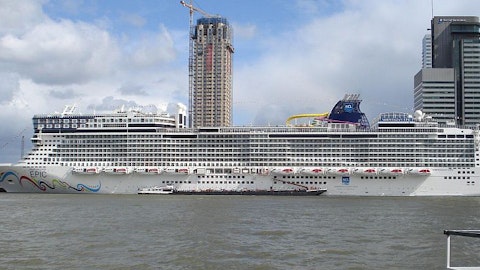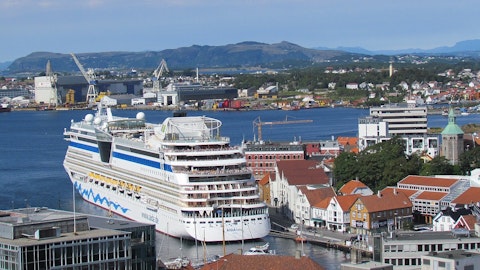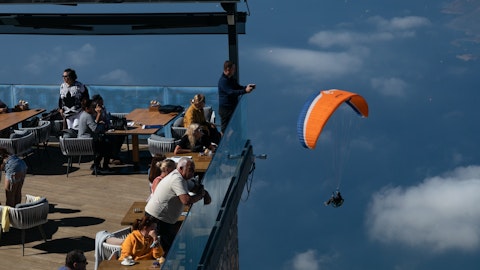Norwegian Cruise Line Holdings Ltd. (NYSE:NCLH) Q4 2022 Earnings Call Transcript February 28, 2023
Operator: Good morning, and welcome to the Norwegian Cruise Line Holdings Fourth Quarter and Full Year 2022 Earnings Conference Call. My name is John, and I will be your operator. At this time, all participants are in a listen-only mode. Later, we will conduct a question-and-answer session and instructions for the session will follow at that time. And as a reminder to all participants, this conference call is being recorded. I would now like to turn the conference over to your host, Jessica John, Vice President of Investor Relations, ESG and Corporate Communications. Thank you, Ms. John. Please proceed.
Jessica John: Thank you, John, and good morning, everyone. Thank you for joining us for our fourth quarter and full year 2022 earnings and business update call. I’m joined today by Frank Del Rio, President and Chief Executive Officer of Norwegian Cruise Line Holdings; Mark Kempa, Executive Vice President and Chief Financial Officer; and Harry Sommer, President and Chief Executive Officer of Norwegian Cruise Line. Frank will begin the call with opening commentary, after which, Mark will follow to discuss our financials before handing the call back to Frank for closing remarks. We will then open the call for your questions. As a reminder, this conference call is being simultaneously webcast on the company’s Investor Relations website at www.nclhltd.com/investors.
We will also make reference to a slide presentation during this call, which may also be found on our Investor Relations website. Both the conference call and presentation will be available for replay for 30 days following today’s call. Before we begin, I would like to cover a few items. Our press release with fourth quarter and full year 2022 results was issued this morning and is available on our Investor Relations website. This call includes forward-looking statements that involve risks and uncertainties that could cause our actual results to differ materially from such statements. These statements should be considered in conjunction with the cautionary statement contained in our earnings release. Our comments may also reference non-GAAP financial measures.
A reconciliation to the most directly comparable GAAP financial measure and other associated disclosures are contained in our earnings release and presentation. With that, I’d like to turn the call over to Frank Del Rio. Frank?
Frank Del Rio: Thank you, Jessica, and good morning, everyone, and thank you for joining us today. 2022 was a year like no other in our company’s 56-year history. As we successfully concluded our great cruise come back, with the last vessel in our fleet reentering service midway through the year. Our team continually push forward to this challenging transition year, achieving several significant milestones on our road to recovery and preparing for the next chapter of our storied brands. With our full fleet back to the high seas, we significantly ramped up occupancy levels carrying nearly 1.7 million guests welcomed our newest ship, Norwegian Prima to our world-class fleet, reached several critical financial inflection points, maintained our industry-leading pricing and perhaps more telling, ended the year in a record booked position for 2023 and at record prices.
These accomplishments are even more impressive when considering they were achieved against the backdrop of lingering COVID-19 impacts as well as ongoing macroeconomic and geopolitical uncertainty. I want to take the opportunity to once again thank our entire team, both shore-side and shipboard for their hard work, dedication and tenacity, which has propelled us forward as we strive to be the vacation of choice for everyone around the world. I’m incredibly proud, honored and inspired to work alongside each and every one of you. And I also want to express our sincere thanks to our loyal guests, value travel partners, lenders, shipyards, investors and all of our stakeholders for their continued support and partnership. Shifting our attention to what is certainly a bright future for our company, let’s turn to slide six, which outlines our current positioning and the key catalysts we have on the horizon.
First, we are encouraged to see that our target consumer, which tends to skew more upmarket in the broader cruise industry, continues to be financially healthy and resilient and is prioritizing consumption of experiences over the purchase of physical goods. We’ve talked previously about the two high-level indicators we carefully monitor to evaluate the willingness of consumers to spend on cruise travel. The first being the length of the booking curve, which is a forward-looking indicator and the second one being onboard revenue, a real-time indicator of a consumer’s actual spending, both of which continue to hold strong with no signs of fading. In fact, the booking window in the fourth quarter was well elongated compared to the same quarter in 2019.
Onboard revenue also continues to be a bright spot with gross onboard revenue per passenger cruise day in the quarter, approximately 25% higher than the comparable 2019 period. The bottom-line is our target consumer continues to be willing to spend on travel and experiences now and in the future. This gives us confidence that not only is the incredible value proposition for cruising resonating with consumers, but the unique and compelling offerings of our three brands are also appealing to their respective markets. Second, we are taking actions across our business to align with our strategic priorities and strengthen the foundation for sustained profitable growth. This includes a broad and ongoing initiative we began in the fourth quarter to improve operating efficiencies and to right-size our cost base so that we can rebuild and enhance our margins.
You may ask why start this initiative now? While the past few years have been unlike anything we could have imagined. First, we were focused on taking the necessary measures to withstand a prolonged and unprecedented period of disruption by minimizing cash burn, raising capital, enhancing our health and safety programs to adapt to a rapidly evolving public health environment and advocating for the industry to restart cruise operations. We then shifted our focus to relaunching our operations while providing our discerning guests the same unparalleled vacation experience they expect from our leading brands. We also took this unique opportunity to raise the bar on pricing for the long-term. Now that our phased occupancy ramp is nearly complete, and our loyal guests know that cruising in our brands is back and even better than before, we are squarely focused on how to maximize profitability as we embark on a period of transformational growth.
Every aspect of our business is being evaluated through the lens of how we can realize our full value potential for all stakeholders. We are exploring further opportunities, first and foremost, to reduce our cost profile and to maximize revenue generation. You’ve likely seen some of the actions we’ve already taken to improve our cost structure, including normalization of marketing spend, corporate overhead reductions, itinerary optimization, supply chain initiatives and thoughtful rationalization of product delivery. We will continue to leave no stone on turn as we identify and evaluate incremental opportunities. And of course, we will not lose sight of our guests, the very heart of our business, and we will continue to prioritize delivering an exceptional guest experience and superior service levels.
The last catalyst I want to touch on is our industry-leading newbuild pipeline. This year, for the first time in our history, we are gearing up to deliver one newbuild for each of our brands, as shown on slide seven, adding over 5,000 additional berths to our fleet including an over 20% increase in our upscale berths. On a capacity day basis, this will result in approximately 19% growth in 2023 compared to 2019. As you can see on slide eight, we have made some modifications to our newbuild pipeline primarily related to the last two shifts in the Prima Class. These ships have been lengthened in part to accommodate the future use of alternative fuels. We now expect gross tonnage for the third and fourth Prima Class to be approximately 10% larger and the fifth and sixth Pima Class ships to be approximately 20% larger than Norwegian, Prima and Viva.
As a result, delivery days have shifted a bit, and we now expect one larger Prima Class ship to be delivered each year from 2025 to 2028. We remain confident in our ability to profitably absorb this capacity with continued consumer demand for travel, our expansion into the many unserved and underserved markets around the world that our brands have not yet tapped into, and on the broader industry’s vast under-penetration particularly when compared to land-based vacation alternatives. Shifting our discussion now to our booking, demand and pricing trends. As you can see on slide nine, in the fourth quarter, our load factor reached 87%, in line with guidance. This is approximately 20% below the comparable 2019 quarter, yet demonstrates another sequential improvement in closing the occupancy gap versus 2019.
This ramp is continuing through the first quarter of 2023 as we have already achieved 100% occupancy in the quarter, leading to a return to historical levels beginning in the second quarter of 2023 and beyond. In terms of pricing, slide 10, illustrates another strong result in the pricing front with our net per DM growth in the fourth quarter of 2022, up approximately 14% on an as reported basis and up 15% in constant currency over 2019. Turning to slide 11, at year end, our cumulative book position for 2023 was within our optimal range of approximately 60% to 65%. We continue to believe this is our sweet spot as it strikes the delicate balance of encouraging guests to book early while also optimizing pricing. Full year 2023 book position is now ahead of 2019’s record performance and at higher prices.
Since we last spoke in November, we have been pleased to see positive booking momentum continue, including a very strong wave season that likely started two months earlier than usual. In fact, November was a record-breaking month for Norwegian Cruise Line as they celebrate a record day, record week and record month of sales boosted by Black Friday and Cyber Monday holiday push. Subsequently, in January, a strong start to traditional wave led the line of setting another record booking month. Our Regent brand also experienced a similar positive reception to it 2023 wave offer launch, which resulted in a record launch day with net booking volume nearly four times last year’s wave launch and 2019 pre-pandemic levels. Our current cumulative book position and the strong demand dynamics that we continue to experience across our brands gives us further confidence that we can achieve our 2023 guidance, which Mark will discuss shortly in more detail.
I’ll be back with closing comments a little later. But for now, I’ll turn the call over to Mark for his commentary on our financial position and outlook. Mark?
Mark Kempa: Thank you, Frank, and good morning, everyone. My commentary today will focus on our fourth quarter 2022 financial results, 2023 guidance and the progress on our financial recovery. Unless otherwise noted, my commentary on net per diem, net yield and adjusted net cruise cost, excluding fuel per capacity day metrics is on a constant currency basis. Slide 12 outlines key metrics highlighting our fourth quarter results, nearly all of which met or exceeded guidance. Focusing on the top line, strong ticket pricing and onboard revenue generation drove total revenue per passenger cruise in the quarter, up approximately 24% versus 2019, with net per diems increasing approximately 15%, continuing the strong pricing performance we have achieved since our re-launch.
Turning to costs, adjusted net cruise costs, excluding fuel per capacity day, was in line with expectations, with the second half 2022 decreasing approximately 10% versus the first half as our operations continue to ramp up. As our 2023 guidance indicates, second half 2022 is not representative of a go-forward run rate. For the second half of 2022, adjusted EBITDA was nearly breakeven. We did, however, achieve another significant milestone in the fourth quarter, generating positive adjusted free cash flow for the first time in three years. This represents another stepping stone as we return to a normalized operating environment. Looking at expectations for the full year 2023 on slide 14. We are pleased to return to our normal cadence of providing annual and quarterly guidance.
Adjusted EBITDA is expected to be in the range of $1.8 billion to $1.95 billion with the high end of our targeted range, representing record adjusted EBITDA for the company. This is expected to translate to adjusted EPS of approximately $0.70 at the midpoint of our guidance. Taking a closer look at the components of this outlook, net per diem growth is expected in the range of approximately 9% to 10.5% as compared to 2019. This translates to net yield for the year expected to increase in the range of 5% to 6.5%. This stellar top line performance is reflective of our go-to-market strategy and emphasis on price discipline. Moving to costs, adjusted net cruise cost ex fuel per capacity day is expected to average approximately $160 for the full year.
This represents a nearly 15% decrease as compared to the average of $187 in the second half of 2022. The key drivers of this expected decrease includes the scaling back and normalization of marketing investments, which were elevated in the second half of 2022 as we focused on resetting expectations and raising the bar on pricing during our re-launch; moderation in hyperinflationary pressures in certain areas, including food and logistics; normalization of capacity days as a result of the elimination of previously acquired protocols; timing and optimization of scheduled drydocks; and finally, the results of our operating efficiency and cost minimization efforts as part of our broad and ongoing margin enhancement initiative that Frank touched on.
Keep in mind that costs are expected to sequentially trend lower over the course of the year as occupancy increases and reduction initiatives are realized, which is expected to lead to a lower cost run rate as we exit 2023 as compared to our full year guidance. As we have consistently communicated, our costs will be elevated when compared to 2019 baseline, both due to normal and hyperinflation over the past three years to four years as well as a mixed headwind as we add higher operating cost capacity, which we do expect will gain a premium on the top-line. I want to reiterate that we are committed to right-sizing our cost base and are taking deliberate actions across our business to best position us for the future as a stronger and leaner organization.
There is no silver bullet, but we will continue to evaluate all opportunities to accelerate revenue and improve operating efficiencies, while continuing to deliver an exceptional guest experience. Our goal is not only to rebuild our margins, but over time, continue to enhance them, and we look forward to demonstrating this improvement over the coming quarters. Now, let’s take a look at our expectations for the first quarter. Compared to 2019 levels, net per diem is expected to increase approximately 6.75% to 7.75%, while net yield is expected to increase approximately 1.25% to 2.25%, primarily as a result of our continued occupancy ramp and with pricing expected to be higher for the remaining quarters of 2023. Adjusted net cruise costs excluding fuel per capacity day is expected to be approximately $165 or approximately 12% below the second half of 2022.
First quarter is expected to be the highest cost quarter due to lower occupancy and as actions taken in recent months to reduce costs will not yet be fully realized. When looking at our implied guidance for the remaining quarters of 2023, the expected decrease in cost is approximately 16% compared to the same period in 2022. Taking all of this into account, adjusted EBITDA for the first quarter is expected to be approximately $195 million and adjusted EPS is expected to be a loss of approximately $0.45. Moving to our balance sheet. Slide 15 demonstrates the results of our deliberate and opportunistic measures to optimize our debt maturity profile. In 2023, we have approximately $1 billion of scheduled debt service, the vast majority of which are related to our export credit agency-backed ship financing.
In recent months, we also addressed a large portion of our 2024 maturities. First, we completed an amendment of our operating credit facility and extended approximately $1.4 billion of this facility by one year to January 2025. Earlier this month, we took advantage of significant improvements in the bond markets to complete a refinancing transaction of the remaining non-extended term loans under the operating credit facility. We issued $600 million of new 8.375% senior secured notes due 2028 and use the proceeds to repay these term loans, allowing us to de-risk and replace near-term debt maturities with longer-dated debt at only a marginally higher cost. As you can see, with these actions, we have a manageable maturity profile over the course of the next few years.
When you look at the totality of our debt, approximately 40% is ECA back debt. This is a unique differentiator of the cruise industry, which is part of a broader connected ecosystem, which includes, among others, the operators, the shipyards and the governments and export credit agencies, all of which rely on shipyards and suppliers for significant economic and employment related benefits. As all of our interests closely align, these partners are incredibly supportive, as demonstrated by the very efficient financing we are able to secure for our new-builds as well as the support they provided during the pandemic. For additional detail on the breakdown of upcoming debt payments, we also provide a detailed schedule on our Investor Relations website.
Turning to liquidity, our overall liquidity position remains strong. And just last night, we announced two transactions, which further enhance our liquidity and outlined on page — on slide 16. First, we revised and extend our existing $1 billion undrawn backstop commitment, as part of the agreement to secure a second year extension option on the commitment, the company issued $250 million of 9.75% notes due 2028. At the same time, we revised the undrawn commitment to reduce the amount to $650 million, with the agreement now extending through February 2024, with the option at our sole election to extend through 2025. We do not currently intend to draw on this commitment. And in total, the combination of these two actions provides the company approximately $900 million of liquidity to the bottom-line.
Second, we also entered into a new $300 million unsecured and undrawn backstop commitment. This facility will be available to draw beginning in the fourth quarter of 2023. Securing this facility provides a backstop for the remaining portion of the non-extending operating credit facility which matures in January 2024. Pro forma for these recent transactions, our liquidity position at year-end is approximately $1.8 billion, which includes approximately $650 million, under the available commitment. For housekeeping, this does not include the enhancement to future liquidity we obtained with the $300 million undrawn commitment as it is currently not available to draw. Before handing the call back — handing the call back to Frank, I want to reiterate our relentless focus on executing on our medium- and long-term financial strategy, as laid out on slide 18.
We will continue to be opportunistic and are committed to delivering value for all stakeholders. But most of all, we are excited to be back in full operation and once again delivering incredible vacation experiences on our three brands to all corners of the globe. With that, I’ll turn it back to Frank for closing comments.
Frank Del Rio: Thank you, Mark. Before we wrap up our prepared remarks, I’d like to provide an update on our global sustainability program, Sail & Sustain, which slide 19 outlines, a few key highlights. Since we last spoke, we have made meaningful progress to advance our commitment to pursue net zero greenhouse gas emissions. We successfully completed the testing of biodiesel fuel blends on three additional ships in our fleet, a promising potential lever to help reduce emissions on our existing fleet. In addition, we recently modified our contracts to the final two PRIMA Class Ships for Norwegian Cruise Line scheduled for delivery in 2027 and 2028 to reconfigure these ships to accommodate green methanol and as an alternative fuel source in the future.
While additional modifications will be needed in the future to fully enable the use of dual fuel, both methanol and diesel, this action reinforces our commitment to decarbonization and represents an important and exciting step forward in our pursuit of net zero. Before turning the call over to Q&A, I’d like to leave you with some key takeaways, which you can find on slide 20. First, we believe we are well positioned in the current economic environment and our target upmarket consumer remains resilient. This is especially true for the all-import North American consumer from we enjoy an outsized benefit, given our strategic sourcing mix and focus on global versus national brands. Second, booking momentum is positive, buoyed by a strong start to the year with wave season, and we are pleased with our book position and pricing for 2023.
Third, we are focused on strengthening the foundation for sustained profitable growth, and we will continue to take strategic measures to best position the company for its next era. And lastly, our cash generation engine continues to rev up which, along with our transformational new build pipeline provides a path to meet our liquidity needs and to restore our balance sheet in the coming years. We’ve covered quite a bit today, so I’ll conclude our commentary here and open up the call for your questions. Operator?
Operator: Thank you, Frank.
Jessica John: Before we get to the questions on the line, we first want to address a top question from our online shareholder Q&A platform, which provides all of our investors another avenue to submit and upvote questions from management. The top question this quarter was what are our plans to bring in new customers and also reward brand loyalists to entice them to cruise. Frank, do you want to take that one?
Frank Del Rio: Sure. I think both past guests and new guests are absolutely critical for our continued growth. We have a great base of loyal guests who love our product because each of our brands have incredibly high repeat rates running anywhere from 45% for the Norwegian brand to as high as 55% for region. And we’re always looking for new ways to engage with them, including through our popular loyalty programs that each brand operates. We also have a robust new build pipeline as we just finished discussing. One new build being introduced for each brand this year alone and we all know new ships and above surrounding new ships have historically brought outsized attention to the brand. Just consider the buzz when Katy Perry performed as godmother of Norwegian Prima this past summer.
And just recently, Giada De Laurentiis was named Godmother of Oceania upcoming Vista, which highlights the brand’s focus on having the fun is to choosing it see. These announcements create excitement, not just among loyal guests, but also to new brand and even new to cruise guests. You’ve heard us say many times that the cruise industry as a whole is vastly underpenetrated, and we have significantly — have a significant runway ahead to attract new to cruise guests, creating awareness, drawing buzz, partnering with a traveling community even having investors such as yourselves, deliver the message, of the value and unique experiences that cruises offer is a large part of what we do every single day, and we’ll continue to do so to drive that message to as many possible guess as we possibly can.
See also 11 Most Profitable Cheap Stocks to Buy and 23 Best Countries in the World to Live in if You’re a Woman .
Q&A Session
Follow Norwegian Cruise Line Holdings Ltd. (NASDAQ:NCLH)
Follow Norwegian Cruise Line Holdings Ltd. (NASDAQ:NCLH)
Operator: Thank you, Frank. Our first question comes from the line of Dan Politzer with Wells Fargo. Please proceed with your question.
Dan Politzer: Hi, good morning. Frank. Good morning, Mark. Thanks for taking my questions. I wanted to touch first on the balance sheet. Obviously, there’s a lot of work that you guys have been doing there. How do you think about leverage this year, next year? And to what extent is your appetite to issue equity relative to debt? Thanks.
Mark Kempa: Hi, good morning Dan. Well, first and foremost, the discussion of issuing equity is a Board decision. So, I will leave it there, but what I can tell you is that, that has not been in discussion in any of our Board meetings. We’ve said time and time and again, we do not believe that it is prudent to issue more equity to de-lever the company. As we look forward and we look at our balance sheet, we have said that our internal goal here is we want to turn the year with a 5x handle. And for clarification, that does include an adjustment for the newbuilds that we take delivery of in this year since we do not have the full earnings potential. But that’s what the company has rallied around, and that’s what we’re focused on.
We’ve said before, it’s not an easy task, but we’re rallying against that, and that’s what we’re using as our stake in the sand. So, there’s a lot of opportunity ahead in the industry and especially for our company for the year. We are in a dynamic environment, all signs that we see are looking good, and that’s evidenced by our pricing power and our Q4 results as well as our guidance for the year. But nevertheless, there is some unknowns out there. So, we’re feeling pretty good right now. We continue on our path of hitting our guidance that we’ve just issued and we feel good about our overall liquidity and balance sheet position where it stands today, but there’s a lot of work to do.
Dan Politzer: Understood. And then just for a follow-up, bookings are obviously positive. You’re putting through all these cost efficiencies. Do you have any expectation as bookings progress and you guys continue to recover when you can get back to that $100 EBITDA per APCD level? And also, along with that, if you could just maybe give a little bit more color on the cost efficiencies, total amount, the time that they’re going to be achieved? And to what extent there could be further room in coming years? Thanks.
Mark Kempa: Great, that’s a lot to unpack there. So, let me start with the EBITDA per capacity day. Look, this is going to take time, right? If we look at where this industry was not so long ago, we — it was only last May of 2022 where we started operating all of our vessels. So, we are progressing. We are hitting our milestones that we’ve laid out for several quarters now. It is a progression. Bookings are doing well. Onboard revenue spend is trending well, but it will take time. It’s not an overnight process. And so, as we think about that, part of that is enhancing our revenue, enhancing margins, obviously, and right-sizing our cost base. We’ve said that our strategy coming out of the pandemic was we wanted to reset the bar on pricing.
We believe we’ve done that, which we believe will be a longer term benefit for all our constituents and now we are squarely focused on right-sizing our cost base. As we look to the future, we’re on a period of transformational growth. We have almost 50% growth between now and 2028, with our scheduled pipeline of deliveries. So, we have to do better, and we are going to do better on leveraging our scale, and that’s what we’re focused on. So, it’s going to come from a lot of different places. But we focused on the topline. Now, we’re squarely focused on the cost, and that’s going to translate to improved margins, which again will then translate ultimately into achieving that pre-pandemic EBITDA per capacity day.






